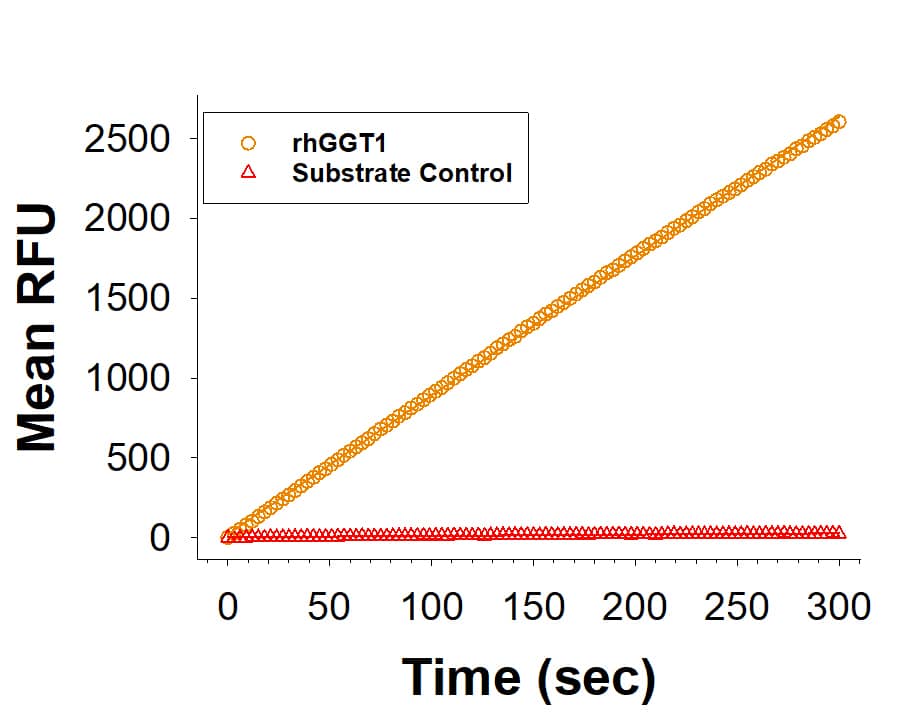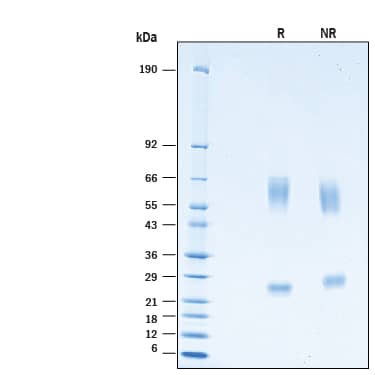Recombinant Human GGT1 His-tag Protein, CF
Recombinant Human GGT1 His-tag Protein, CF Summary
Product Specifications
Pro27-Tyr569 with a C-terminal 6-His
Analysis
Product Datasheets
Carrier Free
CF stands for Carrier Free (CF). We typically add Bovine Serum Albumin (BSA) as a carrier protein to our recombinant proteins. Adding a carrier protein enhances protein stability, increases shelf-life, and allows the recombinant protein to be stored at a more dilute concentration. The carrier free version does not contain BSA.
In general, we advise purchasing the recombinant protein with BSA for use in cell or tissue culture, or as an ELISA standard. In contrast, the carrier free protein is recommended for applications, in which the presence of BSA could interfere.
10977-GT
| Formulation | Supplied as a 0.2 μm filtered solution in Tris and NaCl. |
| Shipping | The product is shipped with polar packs. Upon receipt, store it immediately at the temperature recommended below. |
| Stability & Storage: | Use a manual defrost freezer and avoid repeated freeze-thaw cycles.
|
Assay Procedure
- Assay Buffer: 50 mM Tris, 0.05% Tween® 20, pH 8.0
- Recombinant Human GGT-1 (rhGGT-1) (Catalog # 10977-GT)
- Recombinant Human NQO-1 (rhNQO-1) (Catalog # 7567-DH)
- Glutamate Dehydrogenase (GIDH) (Sigma, Catalog # G7882), 200 U/mL stock in 50 mM Tris, 0.05% Tween® 20, pH 8.0
- Nicotinamide Adenine Dinucleotide ( beta -NAD) (Sigma, Catalog # N6522), 100 mM stock in deionized water
- Resazurin (Catalog # AR002)
- Glutathione, reduced (GSH) (Amresco, Catalog # 399), 250 mM stock in deionized water
- F16 Black Maxisorp Plate (Nunc, Catalog # 475515)
- Fluorescent Plate Reader (Model: SpectraMax M5 by Molecular Devices) or equivalent
- Dilute rhGGT-1 to 0.4 µg/mL in Assay Buffer.
- Prepare substrate mixture containing 2 mM GSH, 100 U/mL GIDH, 2 mM beta -NAD, 40 µM Resazurin and 4 µg/mL rhNQO-1 in Assay Buffer.
- Load in a plate 50 µL of 0.4 µg/mL rhGGT-1, and start the reaction by adding 50 µL of substrate mixture. Include a Substrate Blank containing 50 µL Assay Buffer and 50 µL of substrate mixture.
- Read at excitation and emission wavelengths of 540 and 585 nm, respectively, for five minutes in kinetic mode.
- Calculate specific activity:
Specific Activity (pmol/min/µg) = | Adjusted Vmax* (RFU/min) x Conversion Factor** (pmol/RFU) |
| amount of enzyme (µg) |
*Adjusted for Substrate Blank
**Derived using calibration standard Resorufin (Sigma, Catalog # R3257)
- rhGGT-1: 0.020 µg
- GSH: 1 mM
- GIDH: 5 U
- beta -NAD: 1 mM
- rhNQO-1: 0.2 µg
- Resazurin: 0.02 mM
Scientific Data
 View Larger
View Larger
Recombinant Human GGT1 His-tag (Catalog # 10977-GT) is measured by its ability to hydrolyze glutathione to Glu and Cys-Gly.
 View Larger
View Larger
2 μg/lane of Recombinant Human GGT1 His-tag Protein (Catalog # 10977-GT) was resolved with SDS-PAGE under reducing (R) and non-reducing (NR) conditions and visualized by Coomassie® Blue staining, showing bands at 56-69 kDa and 22-26 kDa, under reducing conditions.
Background: gamma-Glutamyltransferase 1/GGT1
Gamma-glutamyl transferase 1 (GGT1), also known as Gamma-glutamyl transpeptidase 1, is a ubiquitous enzyme that cleaves the gamma-glutamyl bond substrates where the glutamate moiety is available. This makes GGT1 crucial for metabolism of glutathione, the most important cellular antioxidant in humans and for its role in leukotriene biosynthesis, required for lipid metabolism. Although GGT1 comes from a 7 member multigene family, only GGT1 and GGT5 have enzymatic activity (1, 2). GGT5 has 40% amino acid homology with GGT1 and only 4% of the activity (2, 3) making GGT1 the primary contributor to enzymatic activity in the cells. GGT1 is synthesized as a single 569 amino acid polypeptide that is autocleaved by threonine 381 into a mature, activated, heterodimeric glycoprotein composed of a large subunit with an N-terminal hydrophobic transmembrane domain that anchors the enzyme to the membrane and a small catalytic subunit containing the catalytic nucleophile threonine 381 (4, 5). The human GGT1 active site is located in a deep channel but remains in an open configuration (4). It has a unique buried chloride ion that is integral to the protein structure (4). GGT1 contributes to cysteine homeostasis, intracellular redox, and inflammation (2, 6-8) and has been implicated to play a role in Parkinson and cardiovascular disease (5, 9), is a diagnostic marker of several diseases including liver and pancreatic cancer and is induced in several cancers to contribute to resistance to chemotherapeutic agents (7, 10-14).
- Pawlak, A. et al. (1988) J. Biol. Chem. 263:9913.
- Wickham, S. et al. (2011) Anal. Biochem. 414:208.
- Heisterkamp, N. et al. (1991) Proc. Natl. Acad. Sci. USA 88:6303.
- West, M.B. et al. (2013) J Biol. Chem. 288:31902.
- Ndrepepa, G. et al. (2018) Clin. Chim. Acta. 476:130.
- Lieberman, M.W. et al. (1996) Proc. Natl. Acad. Sci. 93: 7923.
- Hanigan, M.H. (2014) Adv. Cancer Res. 122:103.
- Corti, A. et al. (2020) Free Radic. Biol. Med.160:807.
- Sian, J. et al. (1994) Ann. Neurol. 36:356.
- Whitfield, J. B. (2001) Crit. Rev. Clin. Lab Sci. 38:263.
- Lyu, S.C. et al. (2021) Cancer Manag. Res. 13:4887.
- Carr, B.I. et al. (2021) J. Transl. Sci. 7:10.15761.
- Sayan, M. et al. (2021) Wiad. Lek. 74: 1804.
- Jia, Y. et al. (2021) J. Oncol. 9120265.
FAQs
No product specific FAQs exist for this product, however you may
View all Proteins and Enzyme FAQsReviews for Recombinant Human GGT1 His-tag Protein, CF
There are currently no reviews for this product. Be the first to review Recombinant Human GGT1 His-tag Protein, CF and earn rewards!
Have you used Recombinant Human GGT1 His-tag Protein, CF?
Submit a review and receive an Amazon gift card.
$25/€18/£15/$25CAN/¥75 Yuan/¥2500 Yen for a review with an image
$10/€7/£6/$10 CAD/¥70 Yuan/¥1110 Yen for a review without an image
